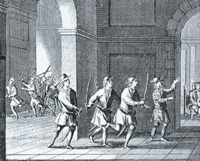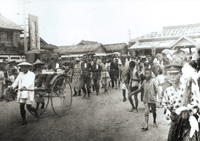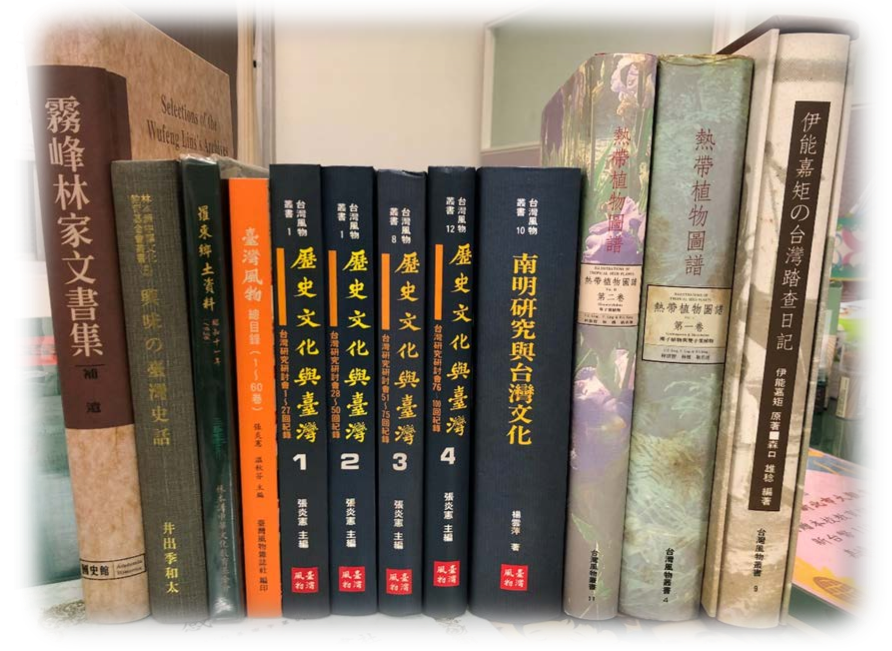
台灣歷史上的民變
Popular uprisings in Taiwan’s history
林呈蓉教授/April C. J. Lin, Professor
(淡江大學歷史系/(Department of History, Tamkang University)
2001-03-26
 One of the most important parts of anThe Pin Tien-mi guard incident of1628, during the era of Dutch rule,illustration courtesy of SMC PublishingInc.
One of the most important parts of anThe Pin Tien-mi guard incident of1628, during the era of Dutch rule,illustration courtesy of SMC PublishingInc.
伴隨著「唐山過台灣」,漢人也將傳統中國社會所有的特質移植到了台灣島上,塑造了台灣歷史「民變頻仍」的現象。「民變頻仍」也充分顯示出長久以來台灣社會一直是處在一種不安定的狀態當中。主要導因於:公權力無法伸張,因此民眾必須自立救助;多數時候台灣社會都是被外來政權所統治,且政權的更迭頻仍,無法滿足當地住民的真實需求;以及島內不同族群必須經常面對激烈的生存競爭。本週請到淡江大學歷史系林呈蓉教授執筆,談談台灣在四百多年的歷史中,歷年來民變事件的種類與導因。
In the wake of “China coming to Taiwan”, HanChinese brought with them to Taiwan thecharacteristics of traditional Chinesesociety, and created the phenomenon inTaiwanese history of frequent popularuprisings. these frequent popular uprisingsalso demonstrate that Taiwanese society hadbeen unstable for a long time. This happenedbecause there was no way to promote publicauthority, and consequently, the generalpopulation had to fend for themselves; mostof the time, Taiwanese society was ruled bya government from overseas, and thispolitical power changed frequently, so itwas impossible to satisfy the practicalneeds of the local inhabitants. Differentethnic groups on the island often had toface intense competition for survival. Thisweek, we have invited Professor April C. J.Lin from the department of history at TamkangUniversity to tell us about incidents ofpopular rebellion through Taiwan’s 400 yearsand more of history, and the reasons behindthem.
民變頻仍
過去一般人對台灣歷史的刻板印象,就是「民變頻仍」。以清王朝統治台灣兩百一十一年的時期為例,各種大小反抗官府的民變就有上百件之多,若再加上民間頻繁的分類械鬥,顯然如俗諺所說的「三年一小反,五年一大亂」,的確是其來有自。然而,這樣的特質並非是台灣社會所特有的,而是伴隨著「唐山過台灣」,漢人將傳統中國社會的特質又移植至台灣島上罷了。在台灣四百年的歷史中,民變的型態以一九一五年為界,大致可以分為四大類型:
Frequent popular uprisings
In the past, most people have had a stereotypedimage of Taiwan’s history, which is “frequentpopular uprisings.” During the 212 years of Qingdynasty rule in Taiwan alone, there were over100 incidents of large and small popular uprisingsrevolting against local government offices, and ifwe add to this the persistent armed fightingbetween different ethnic groups, we can see thatthe old saying, “a little uprising every threeyears, major unrest every five years,” wascertainly based in fact. However, this wasn’ttraditionally characteristic of Taiwanese society;rather, following the arrival of “China in Taiwan,”Han Chinese brought the characteristics of theirtraditional Chinese society with them when theymoved to the island of Taiwan. During Taiwan’sfour hundred years and more of history, popularuprisings can be roughly divided into four maintypes, taking 1915 as a dividing line.
濃厚的民族意識色彩
(一)以漢族為中心,透過民族情緒的訴求,動員民眾起來抵抗,表達對統治當局的不滿。
這樣的案例,從一六五二年荷蘭時代,漢人反抗荷蘭統治的「郭懷一事件」開始,便層出不窮。較為有名的還有一七二一年驚動整個西部地區的抵抗運動「朱一貴事件」;一七八六年清朝時代最大規模的抵抗行動「林爽文事件」,清廷花了四省的兵力,歷時十六個月才彌平;一八六二年席捲台灣中部、歷時四年,以八卦會會眾為首的「戴潮春事件」。一八九五年清廷將台灣割讓給日本,以仕紳階層為首的一群欠缺「民主」概念的人士,竟以「台灣民主國」為號召,試圖抵抗日本帝國的統治,為期五個月;「民主國」事件失敗之後,從一八九五年年底直至一九○二年期間,以北部的簡太獅、中部的柯鐵虎、南部的林少貓為首,打著「抗日」旗幟,在各處進行遊擊行動。接著,從一九○七年蔡清琳鼓勵新竹月眉社一帶住民,侵襲當地日本人官憲與民間人之「北埔事件開始」,一九○八年丁棚二十八宿事件、一九一二年三月林杞埔的劉乾事件、同年六月黃朝的土庫事件、一九一四年羅臭頭的六甲事件、一九一五年二月台中的林老才事件、乃至同年四月餘清芳的西來庵事件,一連串的武裝抗爭行動,皆夾雜著強烈的民族意識色彩。不僅如此,橫跨四個世紀的這些反亂運動還有另一個共同特徵,即多具有舊封建時代「易世革命」的特質,事件的指導者皆企圖以新「皇帝」自居。
Rich layers of national consciousness
(1) With Han Chinese at the core, the demands ofethnic emotion mobilized the common people torise up and fight back, conveying theirdissatisfaction to the ruling authorities.
There were numerous cases of this kind, startingwith the Kue Huai-yit Incident in 1652, when HanChinese reacted against Dutch rule. An even morewell-known incident was the Chu Yit-gui Incidentof 1721, a resistance movement which shook theentire western region. The largest resistanceaction of the Qing dynasty was the Lin Song-bunIncident of 1786, the Qing court used militaryforces from four provinces, and it took 16 monthsto restore peace. In 1862, the Dai Tiao-chunIncident, led by members of the Eight DiagramsSociety, engulfed central Taiwan for four years.In 1895, when the Qing court ceded Taiwan toJapan, a group led by members of the gentry class,who are normally perceived as lacking any conceptof democracy, unexpectedly appealed for a “TaiwanRepublic,” and tried to rebel against Japaneseimperial rule. It lasted five months. After thefailure of the “Republic,” from the end of 1895until 1902, the flag of the “anti-Japanese”movement was raised, spearheaded by Chien Tai-shihin the north, Ke Tie-hu in the central region, andLim Siau-Niau in the south. The movement involvedlaunching surprise attacks all over the place, asand when the opportunity arose. Then, from 1907,Tsai Ching-lin encouraged residents in the area ofYueh Mei She in Hsinchu to invade and attack localJapanese officers and civilians in the PeipuIncident. A long string of armed resistances,including the Tingpeng Incident of 1908, the LinKipo Liu Kan Incident of March 1912, and the HuangChao Tu Ku Incident in June the same year, the LuoChou Tou Liu Chia Incident of 1914, the Lin LaoTsai Incident in Taichung in February 1915, inTaichung, and even in April 1915, Yu Ching-fong’sSeraian Incident, were all imbued with intensenational consciousness. Not only were theseincidents indicative of rich layers of nationalconsciousness, these rebellions and uprisingswhich spanned four centuries had another commontrait, the quality of the old, feudal-era”revolutions aiming to change the world,” and theleaders of these incidents all tried to pose asnew “emperors.”
 Yu Ching-fong’s Seraian Incident of1915, photo courtesy of SMC PublishingInc.
Yu Ching-fong’s Seraian Incident of1915, photo courtesy of SMC PublishingInc.
對異族勢力的反撲
(二)以原住民為中心,對異族勢力的反撲。
早在荷蘭統治時期,台灣原住民便必須面對異民族統治,以及與外來移民族群進行生存競爭的雙重壓力。一六二九年新港社之役、一六三五年麻豆社之役、同年的卡拉陽社之役、一六三六年小琉球社之役、一六四一年華武壟社之役、一六四四年淡水.葛瑪蘭社之役、一六四五年塔卡瑪哈社之役等,原住民的抗爭活動屢見不鮮。明鄭時期,東寧王國的漢族政權對待原住民並不比過去寬厚,原住民襲殺通事、搶糧的事件時有耳聞,一六六一年大肚社之役、一六七○年沙轆社之役、一六八二年竹塹.新港社之役等,在在表現出原住民對於外來統治與異族族群入侵的不滿。到了清朝統治時期,移民台灣的漢族人口日漸增加,多數原住民在反抗之餘,逐漸走向歸化、漢化之途。即使如此,原住民的反抗活動仍是層出不窮,例如一六六九年吞霄社之役、同年北投社之役、一七三一年大甲西社之役、一八七五年加禮宛社之役、一八八八年大莊諸社之役、一八九五年觀音山莊之役等。其中,規模最大的一場抗官事件首推一七三一年大甲西社事件。以大甲西社為中心,外加大肚社、沙轆社、牛罵頭社、樸仔籬、吞霄社、阿里史社等十餘社原住民兩千餘人,由於不堪清廷官憲的剝削與漢族移民的侵墾,乃群起反撲,整個動亂為期一年之後才告結束。到了日本統治時期,雖然日本有一套完備的「理蕃政策」,可以有效地管理原住民族的活動,但是在一九三○年十月仍有霧社原住民,由於長久以來的勞役剝削與文化摩擦,而爆發了震驚全島的「霧社事件」,歷時將近兩個月才告平息。
Counterattack on the power of foreign races
(2) With Aboriginals at the core, counterattackon the power of foreign races.
Early on in the Dutch occupation period, Taiwan’sAboriginals had to face the two-fold pressure ofrule by a foreign race and competition forsurvival with immigrants from overseas. Aboriginalresistances were a common occurrence, andexamples include the Battle of Hsinkang She in1629; the Battles of Ma Tau and Kalayang in 1635;the Battle of Hsiao Liuchiu She in 1636; the Battleof Hua Wu Lung She in 1641; the Battle ofTamshui-Kemalan She in 1644; and the Battle ofTakamaha She in 1645. In the Ming-Cheng period,the Han Chinese political regime of the Tong-ningKingdom treated Aboriginals no more tolerantlythan had the previous regime, and there werefrequent reports of Aboriginals attacking andkilling officials, and raiding grain storehouses.Battles such as the Battle of Tatu She in 1661,the battle of Shalu She in 1670, andChuchien-Hsinkang She in 1682 repeatedly showedthat the Aboriginals were dissatisfied withforeign rule and invasion by foreign races.With the arrival of the era of Qing rule, thenumbers of Han Chinese immigrating to Taiwanincreased by the day, and in addition torebellions, many Aboriginals gradually began toassimilate into the Han culture. Even thoughthis was happening, Aboriginal uprisings stillcame thick and fast, for instance the Battlesof Tunhsiao She and Peitou She n 1669, the Battleof Tachiahsi She in 1731, the Battle of ChialiwanShe in 1875, the Battle of Tachuangchu She in1888, and the Battle of Kuanyin Shan Chuang in1895. Of these, the uprising on the largest scalewas the Tachiahsi Incident of 1731. WithTachiahsi She as its center, but including adozen or more other Aboriginal communities such asTatu She, Shalu She, Niumatou She, Puzaili,Tunhsiao She and Alishih She, they banded togetherand launched a counterattack, because theycouldn’t bear the rapaciousness of the Qingofficials and the encroachment of land by HanChinese immigrants. The unrest lasted for a yearbefore it could be concluded.In the period of Japanese occupation, althoughJapan had prepared a set of “Barbarian Management”policies which could be used to effectivelycontrol the activities of the Aboriginals, inOctober 1930 there were still Aboriginals atBusha (in Mandarin Chinese Wu She) who, havingbeen subject to a long period of forced labor andcultural attrition, erupted in violence and shookthe whole island with the Busha Incident. It tookalmost two months to quell the uprising.
分類械鬥
(三)漢族移民不同族群之間的「分類械鬥」。
台灣的幅員有限,伴隨著漢族移民陸續渡台墾殖,移民之間為了爭奪土地、水利資源,乃以透過姓氏、原鄉認同、職業等淵源所結合而成的宗親會、同鄉會、行郊等組織為後盾,來維護自身的權益。在層出不窮的各類械鬥當中,則以一八六○年西螺、二崙、崙背一帶所爆發的廖、李、鍾三姓的械鬥最為嚴重,歷時三年才被平息。分類械鬥發生時,在清朝統治時期,清廷官憲多半不會馬上插手調停,直到雙方人馬已經是兩敗俱傷時,官憲才會出馬懲處事件的兩造當事人。值得注意的是,在台灣割讓給日本之後,台灣社會逐漸走向近代化、殖民化與法治化,也進而凝聚出新的「台灣人」意識,過去以原鄉情結為中心的「分類械鬥」問題,乃自然而然地消失殆跡。
Armed fighting between different ethnic groups
(3) Armed fighting took place between Han Chineseimmigrants from different ethnic groups.
Taiwan hasa limited area of land, and with Han Chinesecontinuing to immigrate to Taiwan and cultivate andreclaim the land, there was constant competitionbetween immigrants for land and water resources.Therefore, the immigrants organized themselvesthrough identification in terms of family names,hometowns and professions, and formed clanshipassociations, shared hometown associations, guildsand other organizations as support to protecttheir own interests. Amongst the endlessinter-ethnic fighting, the most serious was thearmed fighting that broke out between the threeclans of Liao, Li and Chung in the area of Hsiluo,Erlun, and Lunpei in 1860, which took three yearsto contain. When inter-ethnic armed fights brokeout during the Qing dynasty, the Qing court’sofficials usually would not intervene and patchthings up immediately, until both sides had causeddestruction to each other – only then could theofficials dispatch troops to administer justice tothe people responsible for the fighting on eitherside. It’s worth noting after Taiwan was ceded to Japan,Taiwanese society gradually moved towardsmodernization, colonization and rule of law, anda “Taiwanese” consciousness began to form. Whenthis happened, the previous problem ofinter-ethnic fighting which had been based onhometown affiliations in the old country fadedaway as a matter of course.
具備了近代民族運動的特質
(四)不同於前三種類型的民變,一九一五年之後,伴隨日本統治時期在台灣辦理近代化的國家教育,台灣的民變逐漸具備了近代民族運動的特質。
以一九二一年所發展出且為期十四年之久的「台灣議會設置請願運動」為例;一九二五年二林地區蔗農自行組織「蔗農組合」,而向製糖會社提出蔗農權益要求之案例;或是一九三一年在「台灣民眾黨」第四次黨員大會進行中,突然提出了「結社禁止」令為例,雖然屢屢招致日本統治當局以違反「治安警察法」、或在毫無法源依據的情況下進行逮捕,甚至以妨礙社會安寧為由強迫停止一切集會活動,但卻在在顯示出台灣民眾一反過去的草莽行徑,試圖在現行體制內爭取自身權益的決心。這種蘊涵近代國家特質的社會活動,從一九二○年開始直到一九三七年中日戰爭爆發後必須終止一切組織活動為止,成為台灣社會抵抗異民族統治的另一種新型式潮流。
Characteristics of modern nationalistmovements
(4) Different from the first three types ofpopular uprising, after 1915, following thenational education which was part of theJapanese colonization era modernizations,Taiwan’s popular uprisings gradually beganto have the characteristics of a modernnationalist movement. Take for example the”Petition to Establish a Taiwan Parliament”
movement which started in 1921 and lasted 14years; or the case in 1925, where sugarcanegrowers in the Erlin area organized themselvesinto the “Sugarcane Growers Association”,and brought their demands for rights forsugarcane farmers to the Sugar RefiningAssociation; or in 1931, the fourth partymembers’ congress of the Taiwan People’s Partywhere an order was suddenly raised prohibitingthe organization. Although these activists weretime and again arrested by the Japanese rulingauthorities for violation of the “Peace PoliceLaw,” or even without the slightest basis inlaw, or were forced to stop all gatherings andactivities, under the charge of obstructing thepeace, they frequently demonstrated that thepeople of Taiwan were trying to win the rightto determine their own rights and interestswithin the existing system. This implies thatthe social movements characteristic of modernnations started around 1920, and continueduntil all organization and activities had tostop with the outbreak of the Sino-Japanese warin 1937. This fourth category was a new wave ofTaiwanese social resistance against rule byforeigners.
長期以來處於不安定的狀態中
縱觀台灣四百年的歷史發展,民變頻仍,充分顯示出長久以來台灣社會一直是處在一種不安定的狀態當中。而其不安定的根源主要有三:第一、公權力經常無法有效伸張,因此民眾必須自立救助;第二、多數時候台灣社會都是被外來政權所統治,且政權的更迭頻仍,無法滿足當地住民的真實需求;第三、不同族群一起寄居在如此蕞爾的小島上,族群之間必須經常面對激烈的生存競爭。
A long history of instability
Taking a panoramic view of the last 400 yearsof historical development, there have beenfrequent popular uprisings, providing ampleevidence that for a very long time, Taiwansociety was constantly in a state of instability.There have been three major sources ofinstability: one, it has often been impossibleto extend public authority, and consequentlythe people have been forced to stand up andhelp themselves. Two, on many occasions, Taiwansociety has been ruled by regimes which camefrom outside Taiwan, and these political powershave changed frequently, so there has been noway to satisfy the practical needs of the localinhabitants. Three, when different ethnic groupsliving together on a very small island such asTaiwan, there are bound to be frequent intensecompetitions for survival between the differentgroups.
Edited by Hsu, Shiou-Iuan/ translated by Elizabeth Hoile
(許琇媛編輯/何麗薩翻譯)









